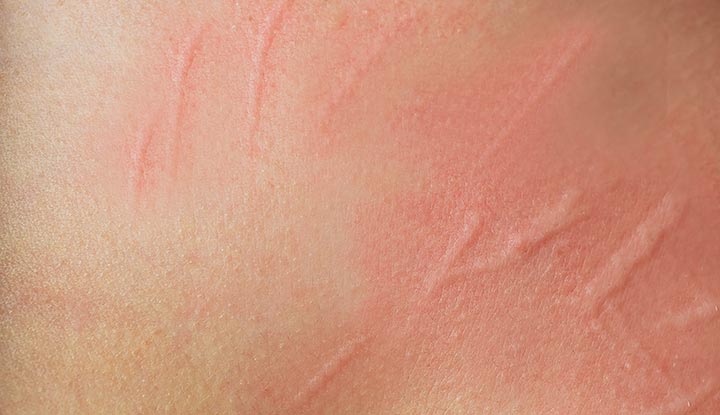Dermatographia is a skin condition that causes raised marks. Scratching, rubbing and pressure cause the reaction. It usually goes away within 30 minutes without treatment. Other names for dermatographia include dermatographism and skin writing.
Advertisement
Cleveland Clinic is a non-profit academic medical center. Advertising on our site helps support our mission. We do not endorse non-Cleveland Clinic products or services. Policy

Dermatographia is a common, benign (not harmful) skin condition. It causes you to develop raised marks (wheals) or a reaction similar to hives when you scratch your skin. Pressure or rubbing (friction) may also cause a reaction.
Advertisement
Cleveland Clinic is a non-profit academic medical center. Advertising on our site helps support our mission. We do not endorse non-Cleveland Clinic products or services. Policy
Dermatographism, dermatographic urticaria and skin writing are other names for dermatographia.
Dermatographia can affect anyone. However, you may be more likely to have dermatographia if:
You may also be more likely to have dermatographia if someone else in your family has it.
Dermatographia is common. It affects about 2% to 5% of the general population.
Dermatographia welts don’t hurt, but they can be itchy. However, you may feel self-conscious or uncomfortable until it fades, usually after about 30 minutes.
Dermatographia symptoms vary from person to person. Your symptoms may include:
Healthcare providers and medical researchers aren’t sure exactly what causes dermatographia.
Dermatographism causes may include:
Stress may cause or aggravate dermatographia. Reducing your stress may help prevent dermatographia flare-ups. Try the following tips to help reduce your stress:
Advertisement
Dermatographia may be an autoimmune disease. Healthcare providers and medical researchers think it might be an inappropriate response from your immune system. Your immune system registers scratching or pressure as an allergen. It sends the chemical histamine to the area to remove the allergen from your body.
No, dermatographia isn’t contagious. You can’t spread dermatographia to another person through skin-to-skin contact.
Your healthcare provider can diagnose dermatographia by agitating your skin. They’ll use a tongue depressor to scratch or press on the skin of your arm or back.
Dermatographia appears within five to seven minutes of agitation. The marks appear in the same direction and orientation as the agitation. It may look like someone wrote on your skin with a pen.
Symptoms of dermatographia are generally mild. They usually go away within 30 minutes.
If your dermatographia is more severe and lasts longer than 30 minutes, treatment options include:
Severe dermatographia that doesn’t respond to the above therapies may be treated with a prescription biologic therapy, which is injected.
Decreasing your stress can also help you get rid of dermatographia. Relaxation activities such as meditation, yoga, tai chi, breathing exercises and muscle relaxation can help decrease your stress and prevent dermatographia.
Common antihistamine side effects may include:
Antihistamine capsules start taking effect about 30 minutes after you take them. They’re most effective after about two hours.
Generally, dermatographia leaves no lasting marks, causing only minor, short-lived irritation and symptoms. The condition may last anywhere from months to years, or you may have it throughout your life.
There isn’t a cure, but for many, dermatographia goes away on its own in a year or two. Or it may grow milder over time so you don’t experience major symptoms.
The following can help reduce your risk of developing dermatographia:
Advertisement
If you have dermatographia, it can generally be well-managed with good skin care and treatment. It usually goes away within 30 minutes, and it isn’t dangerous. Most people don’t see their healthcare provider for treatment.
See your healthcare provider if your dermatographia doesn’t go away within an hour, it appears with other symptoms or is painful.
Dermatographia is annoying, especially if it’s itchy, and it may even be embarrassing. However, it’s common and very normal, and it usually doesn’t affect your quality of life. With a proper skin care routine, stress management and treatment, you can reduce its impact. If you have any questions, your healthcare provider is there to help.
Advertisement
Cleveland Clinic’s primary care providers offer lifelong medical care. From sinus infections and high blood pressure to preventive screening, we’re here for you.

Last reviewed on 05/02/2022.
Learn more about the Health Library and our editorial process.